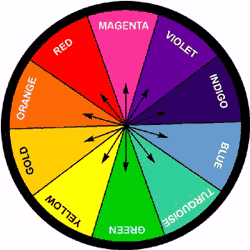Color Therapy
February 5, 2009 Written by JP [Font too small?]We all know that politics make for strange bedfellows. But I’ve got to say that science also brings together some pretty interesting parties. In today’s blog, I’m going to share research that was intended for one purpose, but can be used for a very different reason. Read on and you’ll see what I mean.
Color Me Shocked
Have you ever heard of Chromotherapy? It’s also known as “color therapy” and has been used for thousands of years to help promote healthy states of body and mind (and even spirit, according to some practitioners). The origins of the practice are unclear, but it appears that the ancient Chinese and Egyptians were the first to employ the healing powers of color and light.
 In more modern times, colors have been used in the alternative psychological field to help provide insight into the inner workings of the mind. In fact, a Swiss psychotherapist named Max Luscher developed a test that used color to measure a person’s frame of mind. That diagnostic tool is referred to as “The Luscher Color Test”. During the test, patients are exposed to various colors. The colors they choose (and the order in which they are chosen) are believed to be associated with particular mental states.
In more modern times, colors have been used in the alternative psychological field to help provide insight into the inner workings of the mind. In fact, a Swiss psychotherapist named Max Luscher developed a test that used color to measure a person’s frame of mind. That diagnostic tool is referred to as “The Luscher Color Test”. During the test, patients are exposed to various colors. The colors they choose (and the order in which they are chosen) are believed to be associated with particular mental states.
Here’s a brief overview of what some of the colors represent (according to Dr. Luscher):
- Blue is associated with contentment and belonging.
- Green signifies self-esteem and willpower
- Red represents confidence and a proactive attitude.
- Yellow indicates eagerness to learn and to experience “new encounters”.
In modern medicine, there is a great deal of skepticism about the validity of such tests and about color therapy in general. But fortunately, the prospect of making money sometimes helps to drive scientific research even when the medical establishment is skeptical.
A new study from the University of British Columbia recently explored the potential of color therapy. In the study, over 600 volunteers participated in several controlled tasks – brain exercises that involved creativity or “detail-oriented” exercises. Many of these exercises were performed on computers that had screens with either blue, red or white in the background.
When the researchers analyzed the results of all these performance tasks, they found an interesting association between certain colors and altered mental functioning. Here’s a list of some of their observations:
The color blue promoted creative thinking. The exposure to a blue background lead to twice as much “creative output” as was found with a red background.
The color red promoted “attention to detail”. Red also improved proofreading ability and memory – as compared to the color blue. The rate of improvement was approximately 31%.
 Julie Zhu, one of the authors of the study, commented that the color blue may be best suited for creative endeavors and performance during “cognitive tasks” (like interviews, homework assignments and test taking).
Julie Zhu, one of the authors of the study, commented that the color blue may be best suited for creative endeavors and performance during “cognitive tasks” (like interviews, homework assignments and test taking).
The color red may help make us more careful and vigilant. Therefore it could aid us in making thoughtful decisions on important matters.
The study I just cited wasn’t conducted to help promote our awareness of the impact of colors on brain function. The goal of the study was to determine how colors may be best used in commercial advertising and marketing. But that doesn’t matter to me. We can use observations from one field to help promote our understanding in other areas of our lives. This philosophy is particularly important in the area of natural medicine. Natural medicine simply doesn’t have the same amount of financial resources as conventional medicine. As a result, the quantity of research conducted on alt-med is rather limited. But by keeping our eyes and ears open, we can often find clues in the most unlikely places, that can be applied in our own quest for wellness.
Be well!
JP
Tags: Color Therapy
Posted in Alternative Therapies

February 6th, 2009 at 12:55 pm
Hi JP,
I found this article insightful and intriguing.
I will try to implement it and monitor results!
Great use of alternative resources!
Regards,
Paul
February 6th, 2009 at 1:43 pm
Thank you, Paul.
Please let us know how your personal experiment works out.
Be well!
JP